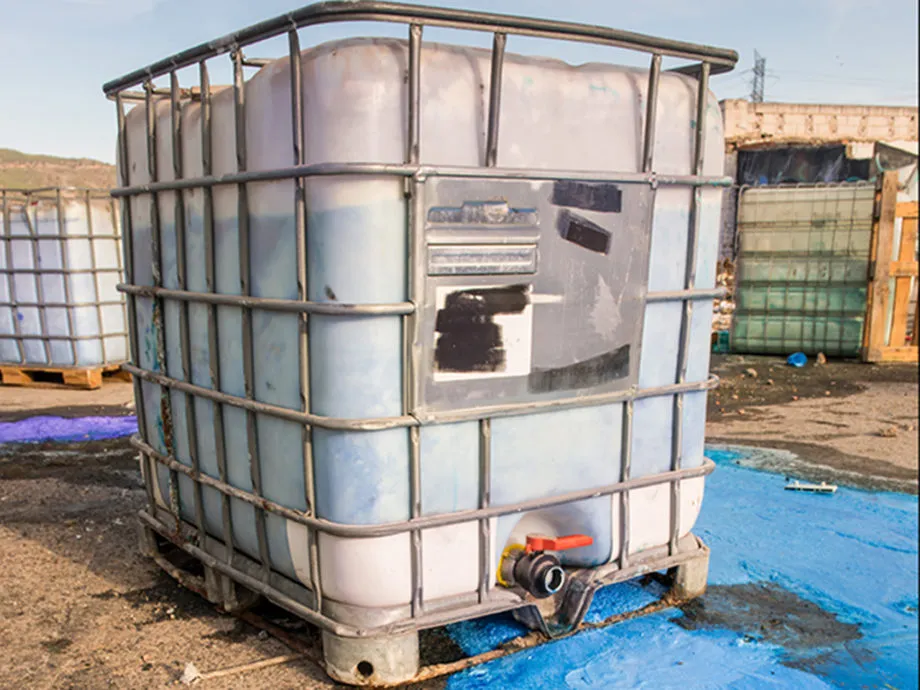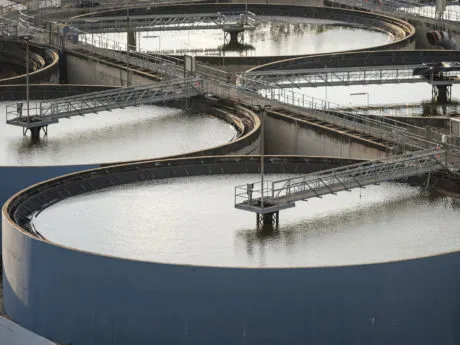Experts' advices
I work in industry
Chemical spills and other leaks
Loading & storage area
The most common accidents occurring in the loading area: bad connection between hoses, a chemical tank overflow or a container fall. In all cases, hazardous products are spilled on the floor or contaminate the equipment (machines, walls, supports and other containers).


Production & maintenance
In this step, the chemical distribution system can be manual or automated. On a supply network, accidents will generally be leaks on the floor from pipes, distribution valves, chemical or retention baths etc… There may also be machine oil leaks and chemical spills during scheduled or emergency maintenance.
Water and effluent treatment
During the water treatment process, flocculants polymers are used to increase filtration and clarification efficacy. These flocculants are not usually considered hazardous chemicals. However, when flocculants are combined with water, they can render the floor slippery and cause accidents.

FREQUENTLY ASKED QUESTIONS
What to do in case of an acid spill ?
This procedure applies in the event of a minor spill that can be managed internally :
- Protect people around you by moving them/evacuating the contaminated area, opening doors and windows if available, and providing adequate personal protective equipment. It is advisable to extinguish any source of ignition in order to not cause accident complications..
- Make a dam around the spill with a neutralizing absorbent, such as TRIVOREX® neutralizing absorbent (for all hazardous liquids) or ACICAPTAL® neutralizing absorbent (specifically for acid spills).
- Sprinkle the absorbent over the spilled liquid. If the residue turns pink it is acid, when it turns back yellow, it is neutral.
- Collect the residue and remove the waste in accordance with the regulations in force.
What if smoke is relesed from an acid spill ?
This procedure applies in the event of a minor spill, i.e. can be managed internally :
- Protect yourself and your employees with breathing apparatus adapted for spilled acid and evacuate all other people. Do not forget that smoke from an acid can irritate the respiratory system.
- Once the spill has been absorbed and neutralized by ACICAPTAL® neutralizing absorbent or TRIVOREX® versatile neutralizing absorbent (also compatible with corrosive acids), the amount of acid vapour will be reduced and the neutralized residue can be picked up more easily.
How to absorb a concentrated and corrosive acid spill ?
A corrosive acid spill must be absorbed by a neutralizing absorbent in order to reduce the risks.
When the acid is a concentrated corrosive, the management of the spill may require an additional step for the product to be completely absorbed and neutralized. To do this, sprinkle ACICAPTAL® neutralizing absorbent or TRIVOREX® versatile neutralizing absorbent all around and over the spill. If the liquid is difficult to absorb or the residue is still acid (pink), LeVert chemical decontaminant (or water in its absence) must be poured onto the absorbent to facilitate absorption and neutralization of the acid.
Never mix water directly with a corrosive acid, this may cause an exothermic reaction. We recommend using a neutralizing absorbent to avoid hazardous reactions.
How to absorb a concentrated soda (soduim hydroxide) spill ?
A soda spill must be absorbed by a neutralizing absorbent to reduce the risk of chemical injuries. In addition, a concentrated soda spill is thick and requires an additional step to be fully absorbed and neutralized. For this, sprinkle BASICAPTAL® neutralizing absorbent or TRIVOREX® versatile neutralizing absorbent all around and over the spill. Then LeVert chemical decontaminant (or water) must be poured onto the absorbent to facilitate neutralization of the waste.
What to do with an acid and base mix ?
An acid and base mix can generate significant heat release (up to ignition) and sometimes more or less dangerous vapours. The solution is to use TRIVOREX® neutralizing absorbent, to reduce the toxic vapours, safely neutralize acid and base mixtures and finally absorb spills to ensure maximum employee safety.
Why should sawdust and absorbent paper not be used to absorb nitric acid or oxidizers ?
When non-specialist absorbents (sawdust, paper towels or cardboard) are used to absorb acid or oxidant spills, a risk of ignition and/or explosion is likely. Certainly, the components of certain non-specialized absorbents can react with oxidants such as nitric acid by an exothermic reaction (heat release). The temperature can then rises quickly and result in a fire. Moreover, the by-products produced by the reaction can be explosive. For example, the reaction between absorbent paper and concentrated nitric acid can form nitrocellulose, an explosive used during the Second World War.
It is preferable to use a product such as TRIVOREX® neutralizing absorbent which will, if necessary, absorb and neutralize the oxidizing product.
How to absorb ammonia ?
Ammonia is often used in its gaseous form. However, it dissolves readily in water, alcohols or other solvents in order to be used in an industrial setting or as a cleaning agent.
An aqueous ammonia solution emits vapours that can irritate the respiratory system. If you wish to absorb and neutralize an ammonia spill, please follow these instructions :
- Evacuate the persons near the spill, protect yourself with the appropriate equipment and secure the zone.
- Make a dam around the spill with a neutralizing absorbent, such as TRIVOREX® (for all hazardous liquids) or BASICAPTAL® (specifically for base spills). They will considerably reduce gaseous emissions, neutralize the basicity of the spill and allow you to collect the residue more easily.
- Put the absorbent on the spilled liquid. If the residue turns pink it is acid, when it turns back yellow, it is neutral.
- Collect the neutralized residues and treat it in accordance with the national regulations in force.
How to clean pipes and valves before use ?
Before any maintenance work on machinery, piping and valves that contain or transport corrosive and irritant chemicals, it is highly recommended to ensure that there are no other chemicals present in the system, to avoid incompatible mixing. New or older leaks and puddles could be spread over the work surface, making the job hazardous for the employee.
Rinse and neutralize piping residues with LeVert chemical decontaminant. This neutral pH solution traps any corrosive chemical: acids, alkaline products, oxidants or even formaldehyde. Using LeVert decontaminant to decontaminate your pipes will simplify and add a degree of safety to your intervention.
In addition, if you want to solidify the leftover or hard to pick up liquid from leakages, you can complete your safety protocol by using TRIVOREX® neutralizing absorbent (for acids and bases).
How to absorb oil while leaving a dry floor?
- Inform people in the vicinity to avoid the risk of slipping or falling.
- Use POLYCAPTOR® universal absorbent to create a dam around the spill. Absorb the spill.
- Collect the residues. The absorbent will mix with the oil without leaving any residue or trace, even on irregular surfaces.
How to absorb and clean flocculant polymers ?
- Inform people in the vicinity of the risk of slipping or falling.
- Use POLYCAPTOR® universal absorbent to create a dam around the spill. Absorb the spill.
- Leave it for a few minutes and then pick up the residues. The absorbent will mix with the flocculant polymers without leaving any residue or trace, even on irregular surfaces.
How to absorb solvents ?
This procedure applies in the event of a minor spill that can be managed internally :
- Inform people in the vicinity of the hazard. Then find the right equipment to protect yourself and secure the area.
- Make a dam around the spill with TRIVOREX® versatile neutralizing absorbent (compatible with all solvents) or POLYCAPTOR® universal absorbent. Then put the absorbent on the spill and wait a few minutes for complete absorption of the liquid. It will allow you to pick up residues more easily without leaving slippery or hazardous marks on the ground.
- Collect residue and remove the waste in accordance with the applicable national regulations.
How to absorb other chemicals?
This procedure applies in the event of a minor spill that can be managed internally :
- Inform people in the vicinity of the hazard. Then find the right equipment to protect yourself and secure the area.
- Make a dam around the spill with TRIVOREX® neutralizing absorbent (compatible with all acids, bases, solvents, oxidants, etc.). It will reduce irritant vapours, neutralize the spill and allow you to pick up the residue more easily.
- Put the neutralizing absorbent on the spill and wait a few minutes for complete absorption of the liquid.
- Collect the residue and treat it in accordance with national regulations in force.
How do I neutralize a chemical splash before removing personal protective equipment (PPE)
When a chemical splash occurs, it is not always detectable or identifiable. Before removing your protective equipment, you and your team must follow an undressing procedure to avoid coming into contact with chemical residue. It may also be necessary to decontaminate the equipment used. The principle is to eliminate any risk of exposure before cleaning or simply discarding this equipment.
Our solution: Rinse and neutralize the concentrated chemicals (especially the corrosive products) on the surface of your chemical protective clothing with LeVert decontaminant. This pH neutral solution can trap any type of chemical : acids, bases, oxidants or others. Using LeVert solution reinforces and simplifies your decontamination protocol.
Water can be used for rinsing but will not neutralize the chemical splash. Only large amounts of water can be used to dilute corrosive and concentrated chemicals. Consequently, there is a substantial amount of liquid waste.
How do I neutralize hydrofluoric acid splashes on personal protective equipment (PPE)?
When a hydrofluoric acid (HF) splash occurs, it is not always detectable or identifiable. Before removing any PPE, in order to limit exposure, you and your team must follow a specific undressing procedure (the simplest procedure is to remove gloves without contaminating yourself). Since contact with HF is extremely dangerous (deadly hazard), we recommend this protocol in order to safely decontaminate any surface possibly polluted by HF.
Rinse and neutralize any possible hydrofluoric acid (HF) splash on the surface of your uniform and other equipment, with LeVert HF decontaminant. This pH neutral solution traps hydrofluoric acid and its fluorinated acid derivatives. It allows you to remove your PPE with an extra degree of safety and simplifies your undressing protocol.
Water can be used for rinsing but will not neutralize the chemical splash. Even if large quantities of water can dilute HF, the hazard may remain in the liquid waste, which is substantial.